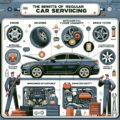Prepare your car for winter with our essential checklist, tire and battery inspections, fluid checks, and emergency kit essentials for safe driving.As winter approaches, ensuring your vehicle is ready for harsher weather conditions is paramount for both safety and performance. The biting cold, snow, and ice can take a toll on your car, making it crucial to prepare ahead of time. This article provides a comprehensive guide on how to prepare your car for winter weather, featuring an essential checklist to keep your vehicle in top shape. From inspecting your tires and checking your battery to ensuring your fluids and wipers are up to par, every detail matters. Additionally, we’ll highlight the importance of an emergency kit and regular maintenance to enhance your car’s winter performance. Embrace the winter season with confidence, knowing you’re equipped with the knowledge to keep your car running smoothly, no matter the weather.
Essential Checklist For Preparing Your Car For Winter
When preparing your car for winter, it’s essential to follow a comprehensive checklist to ensure your vehicle is ready to handle the cold weather conditions. Below is a detailed checklist to guide you through the winter car preparation process:
| Task | Description | Status |
|---|---|---|
| Tire Inspection | Check tire tread depth and air pressure. | ✅ |
| Battery Check | Test battery charge and clean terminals. | ✅ |
| Fluids Inspection | Ensure antifreeze, oil, and washer fluid levels are adequate. | ✅ |
| Wiper Blades | Replace worn wiper blades for better visibility. | ✅ |
| Emergency Kit | Stock essentials like blankets, first aid kit, and snacks. | ✅ |
| Lights Check | Ensure all lights, including fog and brake lights, are functioning. | ✅ |
| Fuel Level | Keep your fuel tank at least half full to prevent fuel line freeze. | ✅ |
| Exterior Wash and Wax | Wash undercarriage to remove salt and grime; wax for protection. | ✅ |
By following this checklist, you can ensure that your vehicle is well-prepared for winter weather challenges, keeping you safe and secure during your travels. Remember, taking the time to maintain your car can drastically improve its performance and longevity through harsh conditions.
Inspecting Your Tires: A Key Step For Winter Preparation
When it comes to preparing your car for winter, one of the most critical aspects is ensuring your tires are ready to handle icy and snowy conditions. Proper tire maintenance can significantly enhance your vehicle’s performance and safety during the winter months.
Here are some essential steps to follow when inspecting your tires:
- Tread Depth: Check the tread depth of your tires. Winter tires should have a depth of at least 6/32 of an inch to provide optimal grip on snow and ice. Use a tread depth gauge or the penny test; if you can see the top of Lincoln’s head, it’s time for new tires.
- Tire Pressure: Cold weather can cause tire pressure to drop. Make sure to check the recommended pressure for your tires (found in the car’s manual or on the driver’s side door) and inflate them as necessary. Properly inflated tires improve fuel efficiency and handling.
- Visual Inspection: Look for any visible signs of wear or damage, such as cracks, bulges, or foreign objects that may be embedded in the tire. Any signs of damage should prompt a professional evaluation.
- Alignment and Balancing: Consider getting your tires aligned and balanced if you notice uneven wear. This helps maintain handling and extends the life of your tires.
By giving your tires the attention they need, you can confidently navigate the challenges of winter driving. Remember, tires are your vehicle’s only contact with the road, so making them a priority in your winter preparation is essential.
Checking Your Car’s Battery To Avoid Cold Weather Issues
Preparing your car for winter involves more than just checking your tires and fluids; one critical aspect often overlooked is the car’s battery. Cold weather can significantly impact battery performance, and ensuring you have a reliable power source is essential for winter driving safety.
Here are some important steps you can take to check your battery and ensure it’s ready for harsh winter conditions:
- Inspect the Battery Terminals: Look for any corrosion or buildup on the terminals. Clean them carefully with a baking soda and water solution if you notice any issues.
- Test the Battery Voltage: Use a multimeter to check the voltage. A healthy battery should read at least 12.6 volts when fully charged. If it’s lower, consider recharging or replacing the battery.
- Check the Battery Age: Locate the manufacturing date on the battery. Most batteries last between 3 to 5 years. If your battery is nearing the end of its lifespan, it’s wise to replace it before winter sets in.
- Consider a Load Test: If you’re unsure about your battery’s reliability, taking it to a mechanic for a load test can provide you with a better understanding of its performance under stress.
- Keep the Battery Warm: If possible, park in a garage during colder months. If you must park outside, using a battery blanket can help maintain warmth and enhance starting ability.
By taking the time to properly check and prepare your battery as part of your winter readiness routine, you significantly reduce the risk of unexpected breakdowns and enhance your vehicle’s reliability when you need it the most. Stay proactive about preparing your car for winter to ensure safe travels throughout the season.
Fluids And Wipers: Crucial Components For Winter Driving
When preparing your car for winter, one often overlooked aspect is ensuring that all necessary fluids are at optimal levels and the wipers are functioning properly. In colder temperatures, having the right fluids can make a significant difference not only in performance but also in safety.
Start with the engine oil; switching to a winter-grade oil can prevent hard starts in frigid temperatures. Consult your owner’s manual for the recommended viscosity. Additionally, check your antifreeze levels. A mixture of 50/50 antifreeze and water is ideal for effective temperature regulation, avoiding radiator freeze and engine damage.
Next, focus on your windshield washer fluid. In winter, it’s crucial to use a fluid that is rated for low temperatures to prevent it from freezing in the reservoir or on your windshield. A fluid with de-icing chemicals can help clear away any icy buildup and improve visibility during those harsh winter months.
Don’t forget about your brake fluid and power steering fluid. Ensure they are at the recommended levels, as low fluid can lead to reduced braking ability and steering performance. If you notice any discoloration or a milky appearance in these fluids, it may be time for a replacement.
Wiper blades also deserve your attention when preparing your car for winter. It’s advisable to replace worn-out wipers before the first snowfall to ensure a clear view during inclement weather. Look for winter-specific wiper blades designed to resist freeze-up and effectively wipe away snow and ice.
Ensure that your wiper reservoir is filled with the appropriate winter washer fluid and test your wipers to confirm they are functioning well. Being proactive about these fluids and wipers can greatly enhance your vehicle’s performance and safety in harsh winter conditions.
Emergency Kit Essentials For Winter Road Safety
When it comes to preparing your car for winter, having a well-stocked emergency kit is essential for ensuring your safety on the road. Winter conditions can be unpredictable, and being prepared can make all the difference. Here’s a list of items you should include in your winter emergency kit:
- Blankets or Sleeping Bags: Keep warm if you get stranded.
- Flashlight: A reliable source of light can help you in emergencies.
- First Aid Kit: Essential for treating minor injuries in case of accidents.
- Food and Water: Non-perishable snacks and bottled water can sustain you during delays.
- Extra Warm Clothing: Hats, gloves, and socks to keep you warm.
- Shovel: Useful for digging your car out of snow if necessary.
- Ice Scraper and Snow Brush: To maintain visibility during winter conditions.
- Jumper Cables: A must-have for dead batteries caused by cold weather.
- Road Flares or Reflective Triangles: To alert others if you’re stuck on the roadside.
- Sand or Kitty Litter: For traction if your tires get stuck in snow or ice.
Incorporating these essentials into your emergency kit will greatly enhance your safety while driving during winter months. Regularly check your emergency kit to ensure all items are in good condition and replace any expired food or supplies. Being prepared is a critical step in preparing your car for winter and can provide peace of mind in challenging weather conditions.
How Regular Maintenance Enhances Winter Car Performance
When it comes to preparing your car for winter, regular maintenance plays a pivotal role in ensuring your vehicle operates efficiently in harsh conditions. A well-maintained vehicle is not just about reliability; it can significantly enhance safety and performance during winter months.
First, routine checks on important systems, including brakes, lights, and heating, can prevent sudden breakdowns when temperatures drop. A thorough inspection of your brakes is essential, as icy roads demand optimal braking power. Likewise, ensuring that your lights are functioning properly increases visibility during winter storms.
Another aspect of regular maintenance involves changing your oil and replacing filters. Engine oil thickens in cold temperatures, which can lead to sluggish performance. Using synthetic oil, which remains fluid in lower temperatures, can be a wise choice in winter, contributing to smoother engine operation.
Additionally, maintaining the exhaust system is crucial as winter conditions can exacerbate any existing issues. Regular inspections can identify leaks or blockages that could cause detrimental effects on not only your car’s performance but also your health, as carbon monoxide can be a serious risk.
Do not overlook the importance of battery maintenance. Cold weather is harsh on batteries, and a simple check can save you from unexpected breakdowns. Ensuring your battery terminals are clean and connections secure can enhance your vehicle’s reliability during winter.
Consistent and proactive maintenance is key to preparing your car for winter. By addressing potential issues ahead of time, you can ensure a safer, more reliable driving experience in challenging winter conditions.
Frequently Asked Questions
Why is it important to prepare your car for winter weather?
Preparing your car for winter weather is crucial to ensure safety, improve vehicle performance, and reduce the risk of breakdowns in harsh conditions.
What are some essential winter car maintenance tasks?
Essential winter car maintenance tasks include checking the battery, inspecting the tires, changing to winter wiper blades, and ensuring the antifreeze levels are adequate.
How can I check if my tires are suitable for winter driving?
You can check your tires by looking for adequate tread depth (at least 3/16 inch), checking for any visible damage, and ensuring they are properly inflated according to the manufacturer’s guidelines.
Should I use winter or all-season tires?
If you live in an area with heavy snow and ice, winter tires are recommended for better traction and handling. All-season tires can be sufficient for mild winter conditions.
How often should I check my vehicle’s battery in winter?
It’s advisable to check your vehicle’s battery at least once a month in winter, as cold temperatures can significantly affect battery performance.
What should I keep in my car for emergencies during winter?
You should keep items like a blanket, flashlight, water, snacks, a first aid kit, and a basic tool kit, as well as a shovel and road flares for emergencies during winter.
How can I improve visibility while driving in winter?
Improving visibility can be achieved by using winter wiper blades, ensuring your windshield washer fluid is rated for low temperatures, and regularly clearing snow and ice from your windshield and lights.












